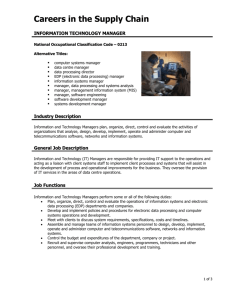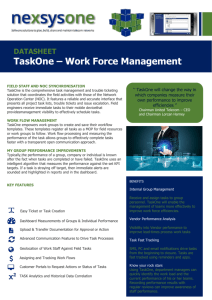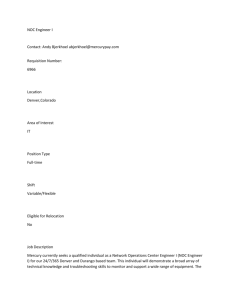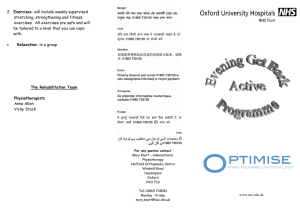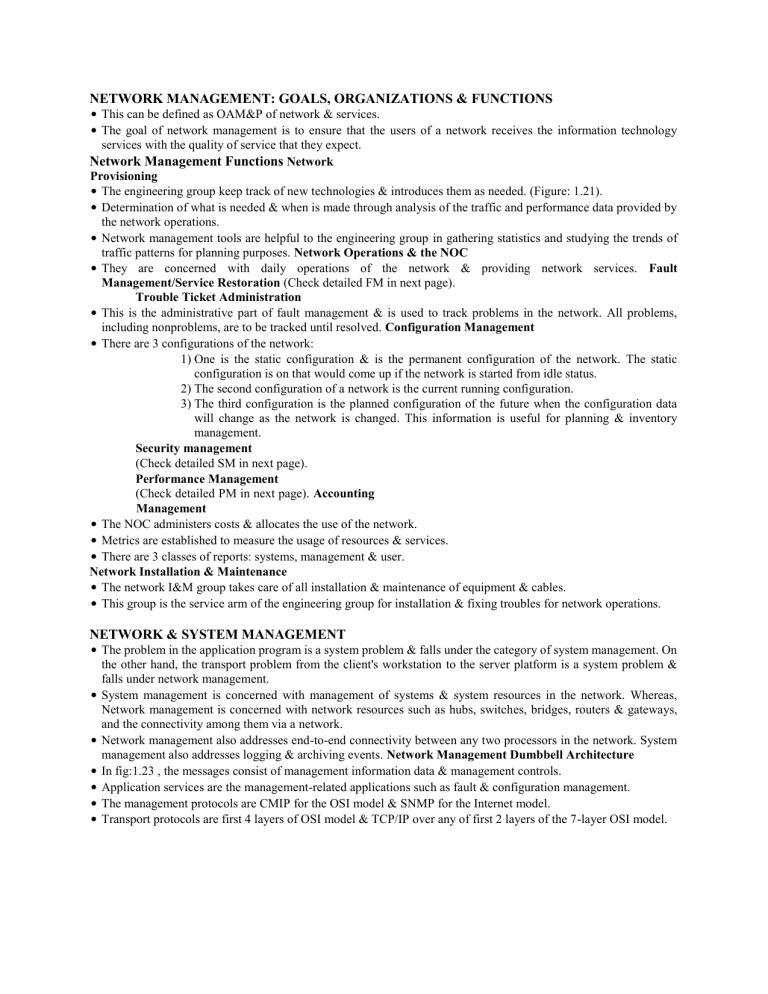
NETWORK MANAGEMENT: GOALS, ORGANIZATIONS & FUNCTIONS
•
This can be defined as OAM&P of network & services.
•
The goal of network management is to ensure that the users of a network receives the information technology services with the quality of service that they expect.
Network Management Functions
Network
Provisioning
•
The engineering group keep track of new technologies & introduces them as needed. (Figure: 1.21).
•
Determination of what is needed & when is made through analysis of the traffic and performance data provided by the network operations.
•
Network management tools are helpful to the engineering group in gathering statistics and studying the trends of traffic patterns for planning purposes. Network Operations & the NOC
•
They are concerned with daily operations of the network & providing network services. Fault
Management/Service Restoration (Check detailed FM in next page).
Trouble Ticket Administration
•
This is the administrative part of fault management & is used to track problems in the network. All problems, including nonproblems, are to be tracked until resolved. Configuration Management
•
There are 3 configurations of the network:
1) One is the static configuration & is the permanent configuration of the network. The static configuration is on that would come up if the network is started from idle status.
2) The second configuration of a network is the current running configuration.
3) The third configuration is the planned configuration of the future when the configuration data will change as the network is changed. This information is useful for planning & inventory management.
Security management
(Check detailed SM in next page).
Performance Management
(Check detailed PM in next page). Accounting
Management
•
The NOC administers costs & allocates the use of the network.
•
Metrics are established to measure the usage of resources & services.
•
There are 3 classes of reports: systems, management & user.
Network Installation & Maintenance
•
The network I&M group takes care of all installation & maintenance of equipment & cables.
•
This group is the service arm of the engineering group for installation & fixing troubles for network operations.
NETWORK & SYSTEM MANAGEMENT
•
The problem in the application program is a system problem & falls under the category of system management. On the other hand, the transport problem from the client's workstation to the server platform is a system problem & falls under network management.
•
System management is concerned with management of systems & system resources in the network. Whereas,
Network management is concerned with network resources such as hubs, switches, bridges, routers & gateways, and the connectivity among them via a network.
•
Network management also addresses end-to-end connectivity between any two processors in the network. System management also addresses logging & archiving events. Network Management Dumbbell Architecture
•
In fig:1.23 , the messages consist of management information data & management controls.
•
Application services are the management-related applications such as fault & configuration management.
•
The management protocols are CMIP for the OSI model & SNMP for the Internet model.
•
Transport protocols are first 4 layers of OSI model & TCP/IP over any of first 2 layers of the 7-layer OSI model.
NETWORK OPERATIONS & THE NOC (in detail)
FAULT
MANAGEMENT
•
This involves detection & isolation of the problem that caused the failures, and restoration of the service.
•
Whenever there is a service failure it is NOC's responsibility to restore service as soon as possible. In several failure situations, the network will do this automatically. This network feature is called self-healing .
•
An NMS can also detect failures of components & indicate them with appropriate alarms.
•
The responsibility to fix the problem usually rests with the I&M group.
•
A trouble ticket is generated manually by a source engineer at NOC using a trouble-ticket system or automatically generated by an NMS.
•
The information on the trouble ticket includes
→ a tracking number assigned by the system
→ time at which problem occurred
→ the nature of the problem
→ affected user
→ the responsible group/engineer to resolve the problem
•
The tracking of a trouble involves several groups and the administration of it generally belongs to the network maintenance group.
SECURITY MANAGEMENT
•
This involves physically securing network, access to network resources & secured communication over network.
•
Access privilege to application software is not the responsibility of the NOC unless the application is either owned or maintained by the NOC.
•
A security database is established & maintained by the NOC for access to the network & network information.
•
Unauthorized access to the network generates an alarm on the NMS at the NOC.
•
Firewalls protect corporate networks & network resources from being accessed by unauthorized personnel & programs including virus programs.
•
Secured communication prevents tampering of information as it traverses the network, so that is cannot be accessed or altered by unauthorized personnel. Cryptography plays a vital part in security management.
PERFORMANCE MANAGEMENT
•
This is concerned with the performance behavior of the network.
•
The status of the network is displayed by a NMS that measures the traffic & performance of the network.
•
The NOC gathers data & keeps them up to date to tune the network for optimum performance.
•
The network statistics include data on traffic, network availability& network delay.
•
The traffic data can be captured based on volume of traffic in the various segments of the network.
•
Performance data on availability & delay is useful for tuning the network to increase the reliability & to improve its response time.
•
Traffic statistics are helpful in detecting trends & planning future needs.
ACCOUNTING MANAGEMENT
•
The NOC administers costs & allocates the use of the network.
•
Metrics are established to measure the usage of resources & services.
•
There are 3 classes of reports: systems, management & user.
•
System reports are needed for network operations to track the activities. Management reports go to the management of the network management group to keep them informed about the activities & performance of the NOC & the network. The user reports are distributed to the users on a periodic basis to let them know the status of network performance.

